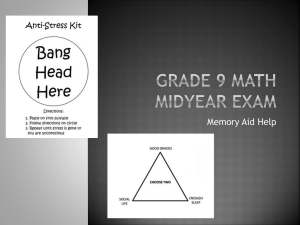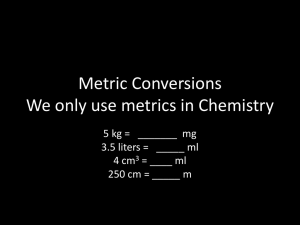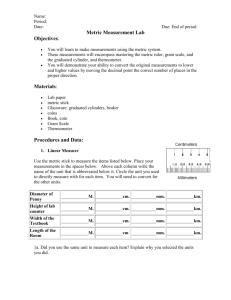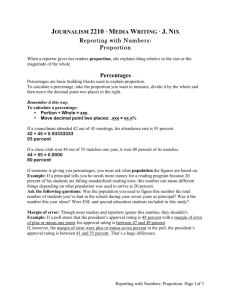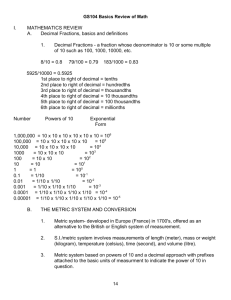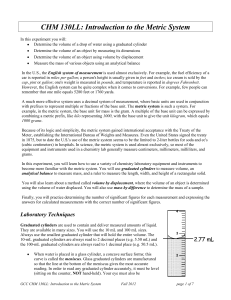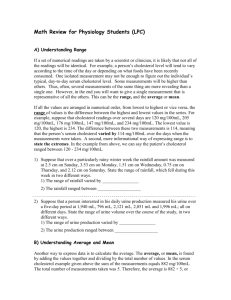Chapter Two Study Guide
advertisement
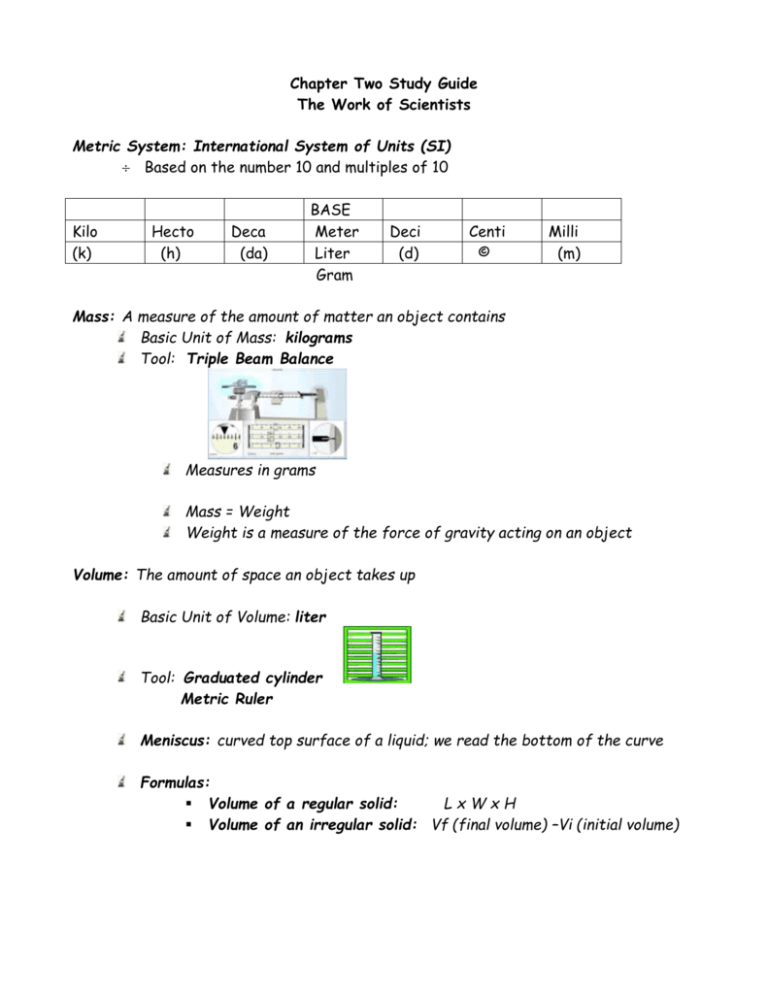
Chapter Two Study Guide The Work of Scientists Metric System: International System of Units (SI) Based on the number 10 and multiples of 10 Kilo (k) Hecto (h) Deca (da) BASE Meter Liter Gram Deci (d) Centi © Milli (m) Mass: A measure of the amount of matter an object contains Basic Unit of Mass: kilograms Tool: Triple Beam Balance Measures in grams Mass = Weight Weight is a measure of the force of gravity acting on an object Volume: The amount of space an object takes up Basic Unit of Volume: liter Tool: Graduated cylinder Metric Ruler Meniscus: curved top surface of a liquid; we read the bottom of the curve Formulas: Volume of a regular solid: LxWxH Volume of an irregular solid: Vf (final volume) –Vi (initial volume) Density: The quantity of mass contained in a given volume All substances have a specific density The size of an object does not change the density because as size increases so does volume. Basic Units of Volume: g/ml or g/cm Tools: Triple Beam Balance (mass) Graduated Cylinder (volume) or Metric Ruler (volume) Density of water = 1.0g/ml Temperature: The measurement of how hot or cold something is SI Unit: Kelvin (K) Tool: Thermometer – we use Celcius Mathematics and Science Estimation: an approximation of a number based on reasonable assumptions Scientists rely on estimates when they can not obtain exact Numbers Accuracy and Precision Accuracy: how close a measurement is to the true or accepted value Precision: how close a group of measurements are toe each other Significant Figures: all the digits in a measurement that have been measured exactly, plus one digit whose value has been estimated. Rule for Adding or Subtracting significant figures 1. The answer can have only as many figures after the decimal point as the measurement with the fewest figures after the decimal Example: 5.3 cm (1 significant figure after the decimal) + 21.94 cm (2 significant figures after the decimal) 27.24 cm = 27.2 cm (b/c 5.3 has only 1 sig fig after the decimal point) Rule for Multiplying or Dividing significant figures 1. When multiplying or dividing, the answer can only have the same number of significant figures as the measurement with the fewest significant figures. Example: 2.25 m (3 significant figures) X 3 m (1 significant figure) 6.75 m = 7m (1 significant figure) The answer has 1 significant figure because the least precise measurement (3 meters) has one significant figure Percent Error: a calculation used to determine how accurate or close to the true value an experimental value really is. 1. Formula to calculate Percent Error Experimental value – True value True value 100% Low Percent Error: very accurate results High Percent Error: not very accurate results Mean, Median, Mode Mean: numerical average 1. To find the mean: Add up all the numbers and divide by the total number of items. Example: 110 102 110 107 109 110 94 94+102+110+107+109+110+110 =742 742 7 = 106 (the average) Median: middle number in a set of data; to find the median place all numbers in order from smallest to largest Odd number of entries: median is middle number Even number of entries: median is two middle numbers added Together and divided by 2 Example: 94 102 110 107 109 110 94 110 Order numbers: 94 102 107 109 110 110 110 Odd amount of numbers, 109 middle number Mode: number that appears the most often in a list of numbers Example: 94 102 107 109 110 110 110 Mode = 110 (110 occurs 3 times) Graphs: a graph is a picture of your data which shows us patterns or trends Graphs 1. Line Graph: shows how the responding variable changes in response to the manipulated variable. Parts of a Graph 1. Horizontal Axis: graph line that runs left to right 2. Vertical Axis: graph line that runs up and down 3. Origin: the point where the x-axis and y-axis cross 4. Coordinate: a pair of numbers used to determine the position of a point on a graph 5. Data point: the point showing the location of a piece of date 6. Line of best fit: shows the overall trend in the data **When no trend is identifiable in a graph there is not relationship between the two variables. 7. Slope: the steepness of the graph line; the ratio of the vertical Change (rise) to the horizontal change (run) **Formula** Slope = Rise = Y - Y Run X - X Example: Two coordinates (20,10) (50,25) Slope = 25-10 = 15 = 0.5 50-20 30
